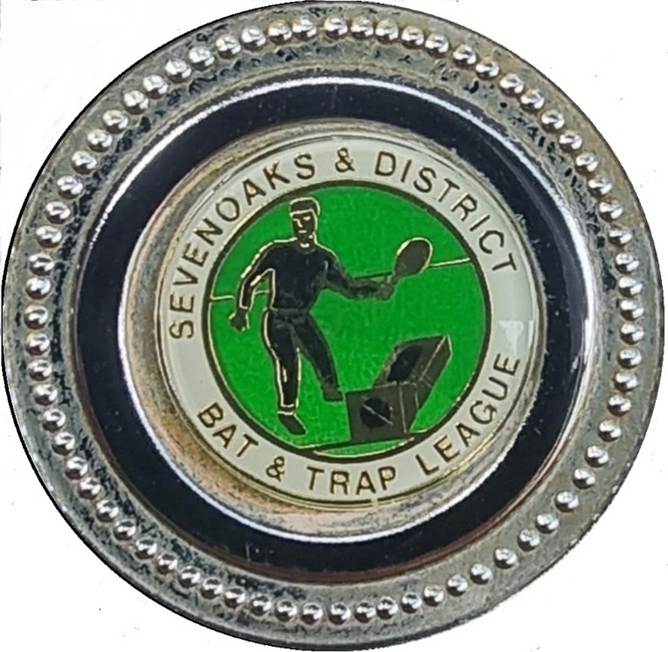
The Home of
Bat and Trap
in the Sevenoaks District
Introduction
Bat and Trap is something of a Kentish tradition. The game, which is related to Knur and Spell, Cricket and Stool Ball was first played in the 14th century.
To play this fine game a Pitch is required 21 yds long and of any width. At one end is the Trap, at the other, the Goal consisting of two 7ft posts 13ft 6ins apart, this end is also the Bowling end. A wooden Bat 18 ins long is needed and a Ball of solid rubber. Teams consist of six people.
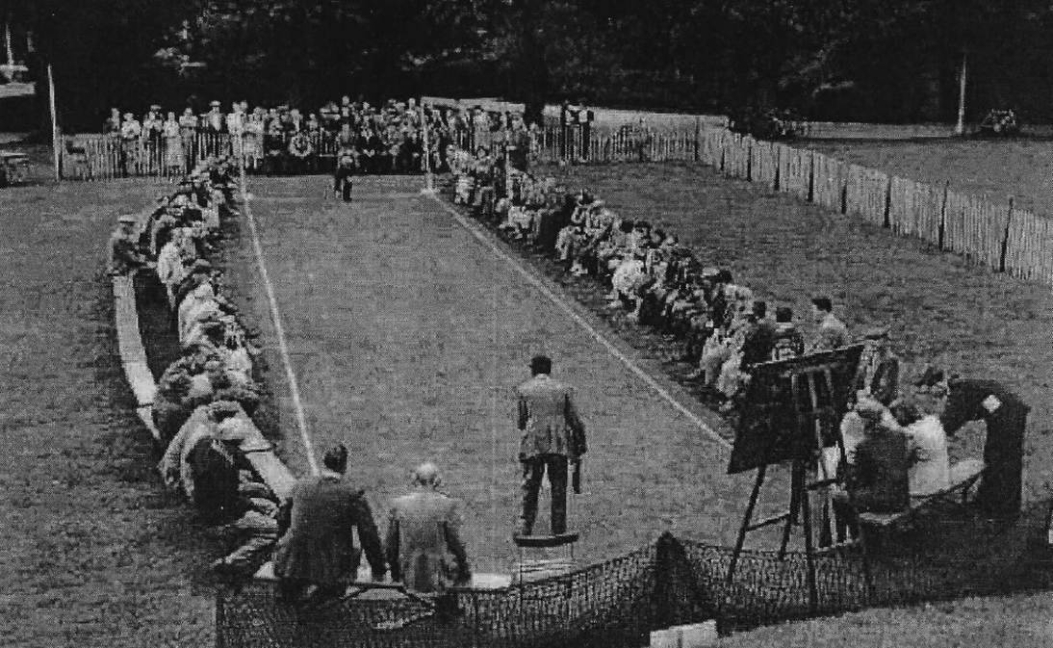
The first Batsman places the Ball on the front of the Trap, then strikes the back of the Trap with his Bat. As the Ball rises the Batsman attempts to hit it between the Goal posts. He is out if the Fielders, standing on the line of the posts, catch the Ball, or if it goes outside the posts. Then, in turn, the Fielders bowl underarm trying to hit the undefended Trap. Each time they miss, the Batsman scores a Run. When the Trap is hit the Batsman is Out and the next member of the team is In.
The picture shows the "Canterbury British Legion" v. "Post Office Telephones" match from the 1954 Festival cup which was played beside the Dane John monument in central Canterbury. By kind permission of Howard Hammond-Edgar, Secretary of the Canterbury and District League.
History
The traditional Kentish game of Bat and Trap is thought to have been devised in the early 17th century by descendants of the Flemish weavers who had settled in the area. It derives from an earlier game, traces of which are found in medieval Dutch literature. "Battenschlag Traapbolsmen" and "Pieter Bruegel The Elder" who also captured this version of the game for posterity in his black chalk drawing called "The Chatsworth Collection.'
Artefacts uncovered in 1981 in the second Millenium BC Thracian Tomb near the village of Sveshtari (an area between the Yantra and the Black Sea) included a rudimentary trap. Perhaps one of the favourite play things of the ancient Balkan ruler of the Getic dynasty who was buried there. It can be seen in the Sveshtari Room at the Bulgarian Academy of Sciences.
Another story goes that milkmaids started the game by throwing stones at their upturned stools while waiting for their shepherd husbands to return from the fields, before that they passed the time throwing stones at "wicket gates", (a kind of field gate). A more concrete fact is that the game, in 1671 was apparently played in North Wiltshire, North Gloucestershire and also near Bath. At that time the ball was 4� inches stuffed with quills and very hard. The bat was a "staffe" made of withy about 3 1/2 feet long.
The game died out after the 17th century but in 1916 Major Grantham of Balneath Manor Sussex, re-kindled it as a healthy pastime for Soldiers convalescing and it has been alive there ever since. In fact, in its modern format, Bat and Trap was re-introduced in the 1914 - 1918 War as recuperation therapy for the thousands of limbless service men returning from the trenches of the western front.
Overshadowed for generations by a derivative game that came to be known as Cricket, Bat and Trap was brought out of obscurity, given new rules and organised into a short - lived National Championship by a bureaucrat in the Ministry of Health called Archibald Levers-Lansdowne. Cricket, he rightly anticipated, was too active for the limbless but Bat and Trap encompassed all the solid elements of competition, quickness of hand and eye and the beneficial open-air environment so beloved by the Edwardian ages.
Special concessions were made to permit the use of materials that otherwise would have been used by the Ministry of Munitions for the war effort, and the first published design of a standard trap was produced under the Ministry's imprint for circulation to all participating groups. Copies of the rules were even sent out to the British Expedition force in Flanders, Ypres and Mons, and the game was avidly taken up (albeit not for long) by our French allies along the river Marne. The first recorded "International" took place between able bodied British and French troops on the eve of the advance at Passchendaele in August 1917. The outcome is not known as no survivors of either team emerged from the battle that followed. Today's Bat and Trap is a sport that balances precariously on the brink of obscurity.

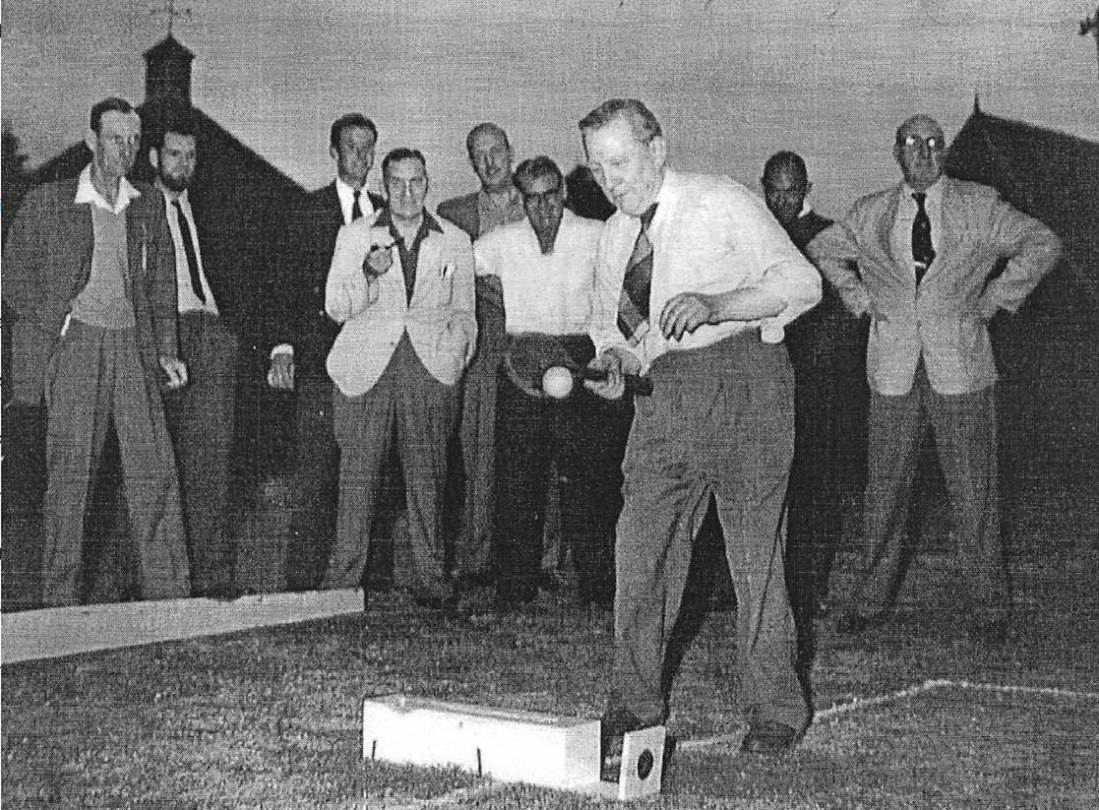
Archibald Levers-Lansdowne's new rules published for the first time in 1915 are largely used today and requires teams of between four and ten players to meet on a 21-yard pitch and, "in a spirit of tolerance and generosity" would take turns to score runs and take wickets. As the Old Contemptibles died off and the social structure of England changed through the passing decades, many of the lower orders were resettled in parts of Kent.
Like many old customs, the game's popularity dwindled in the 19th century. Credit for its revival in 1921 in Canterbury, is attributed to a man called Bill Humphries who stumbled across Archibald Levers-Lansdowne's old rule book and learned that not only was the ancient sport of Bat and Trap a form of ritual rivalry played in the open air, but most importantly that it was a traditional game played outside pubs during drinking hours. The present "Canterbury and District Bat and Trap League" was formed about a year later and has grown steadily since and subsequently joined by a Sevenoaks and District League.
It is good to realise, in our world of sophisticated high-tech sports and entertainment, that a simple, open-air game played way back in mediaeval times, should have such a growing following. The friendly spirit of Bat and Trap, and the fact that it can be played by people of all ages, helps it attract more support every year.



Equipment
The Pitch:
The game is usually played outside the pub, on a pitch in the beer garden. The dimensions of the pitch are 21 yards (19.20m) long measured from the front of the trap at one end and the two posts 13' 6'' (4.11m) apart at the other end. If this is impossible an alternative pitch can be used 18 yards (16.46m) long with posts 12' 6'' (3.81m) wide. The pitch should be as flat as possible. A white line must be drawn between the posts at the bowling end, which is known as the bowling line, a rope can also delineate this. It is also advisable to have fencing or netting behind the bowling end of the pitch to stop the ball.
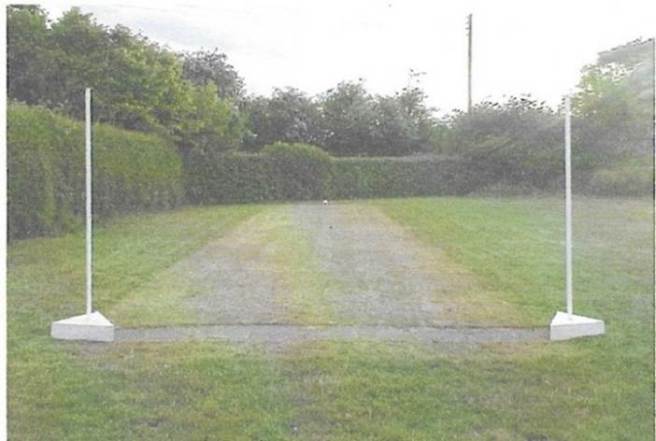

The Posts
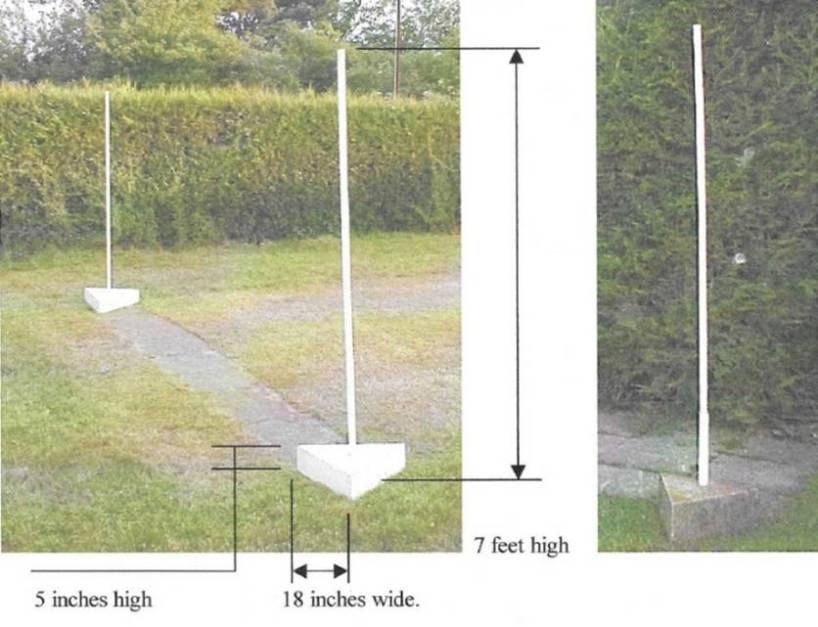
The Posts are either made of hard wood with a dowel pole or, alternatively, a plastic pipe 34mm in diameter can be used. The posts located at the bowling end are made either of wood or 1 1/4 inch (32mm) plastic lengths of pipe and must be 7 feet (2.13m) high from the ground to the top of the dowel pole. The base used to hold the pole vertically must be triangular in shape with one side on the bowling line as shown in the picture. The base is usually approximately 18 inches (45.72cm) length on each triangular side and 5 inches (12.7cm) in height.
Alternatively, some venues prefer to make concrete bases with a sleeve, which can be left outside all year round only inserting the pole for matches.
The Trap
The Trap is usually made of hard wood, which is placed at the batting end.
The mechanism as defined by a dictionary of sport, is "a device varying in form and construction in different places, being employed to spring the ball into the air, to be struck away by the batsman". This device is made to ensure the ball is hit vertically into the air by the bat. The approximate dimensions of the trap are seen on the right.
The target or trap at the front of the device is a 5-inch (12.7cm) square hinged piece of wood with a 2 1/4 inch (5.72cm) diameter target painted centrally on it and fixed flush to the ground.
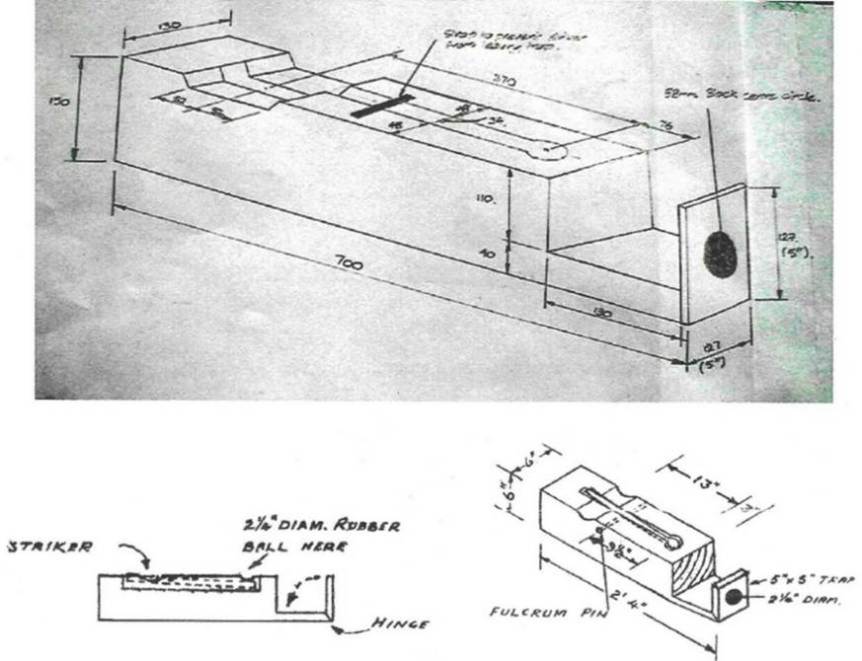
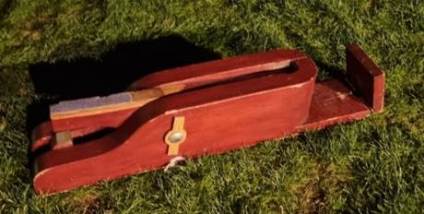
Left is a picture of a trap.
The Bat
The bat is made of solid wood and the striking surface is usually ovaloid and not more than 8 inches (20.32cm) in length and 5.5 inches (13.97cm) in width. No material can be fixed to the strike surface. The bat must be un-sprung and the length of the handle must not exceed 10 inches, making an overall maximum length of 18 inches (45.72cm).
Here are examples of bats within the prescribed rules.
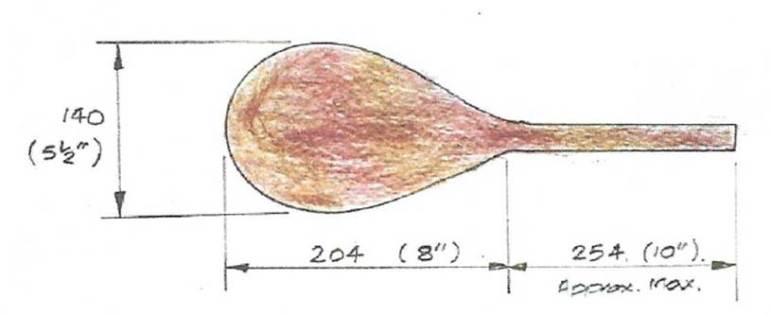
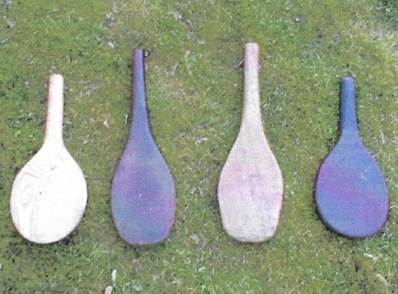
The Ball
The ball used is a heavy-weight solid rubber lacrosse ball 2 1/2 inches (6.35cm) in diameter coloured white or yellow, although white is the preferred colour. These can be purchased from established sports shops.

Floodlighting
As the game is played outside between May and September and some matches can finish quite late, every venue will require lighting for their pitch. It also advisable to provide some form of netting behind the bowling end of the pitch.
Playing the game of Bat and Trap
The season starts at the beginning of May and usually ends in September depending how many matches are postponed due to inclement weather.
Each team consists of six players, although fewer can play but the depleted side has to give away a free run, in place of the missing player every sixth bowl.
Captains will toss a coin to decide the order of play - one team batting and the other bowling - before commencing the match and after each leg.
The first of the six batters will then walk to the trap, places the ball on the front of the trap and then strikes the back of the trap with the bat. As the ball raises the batter attempts to hit it between the goal posts.
There are primarily two methods adopted by batters of hitting the ball, either from the side or behind the trap.
Batting from the side of the trap:
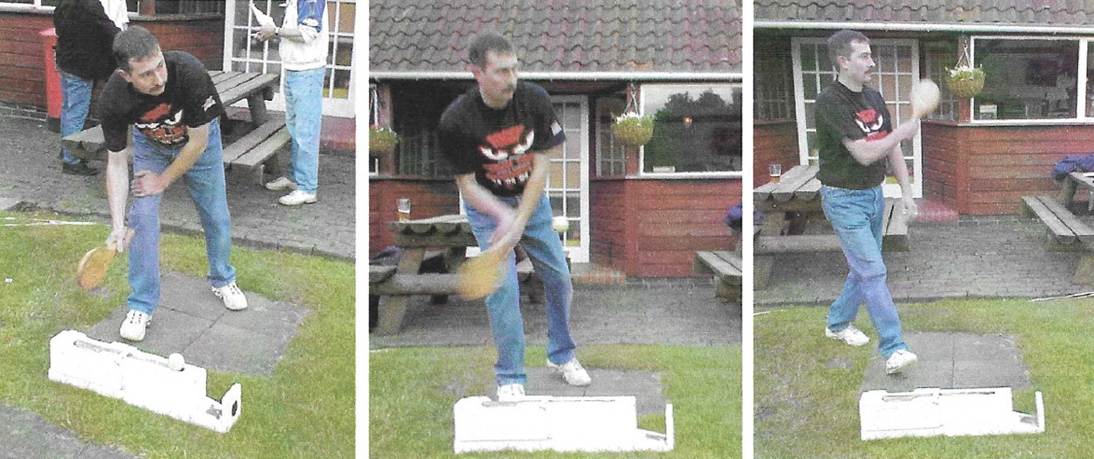
Batting from behind the trap:
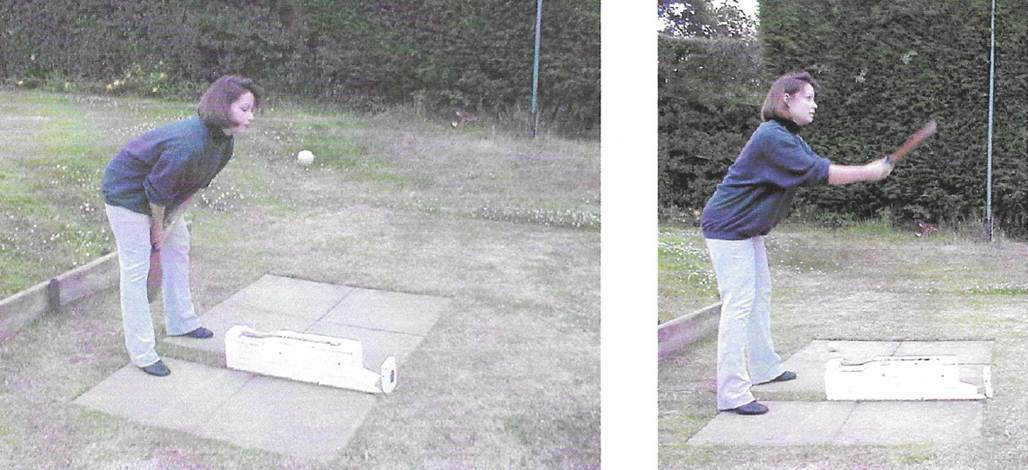
The batter is allowed to strike the trap twice without hitting the ball. However, should the batter strike at the ball and miss then they are out. If the batter fails to hit the ball between the posts, then they are out. After the batter has struck the ball, it must contact the pitch at least once before it passes through the posts or the batter is declared out. This is known as the "fast ball" rule.
If a fielder catches the ball the batter is out, providing the catcher has one foot touching the ground on or behind the line and the ball is caught in front of the line.
The batter, having struck the ball between posts, shall then stand well clear of the trap (but not behind it) until the ball is bowled back.
The batter must not touch the ball before it has passed the trap or comes to rest before reaching the trap. All team batters must ensure that they are available immediately once the preceding team member is deemed out.
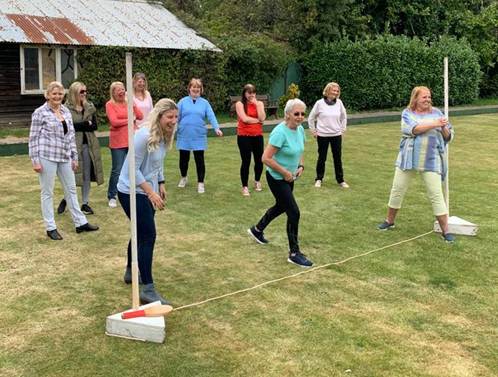
Bowling:
When the batter has hit the ball over the bowling line successfully, one of the bowling team takes the ball and bowls underarm back at the trap, aiming for the flap on the front. If the flap falls, the batter is out and the next batter approaches the trap. (Note that the batter is not out if the ball hits the flap but fails to make it fall).
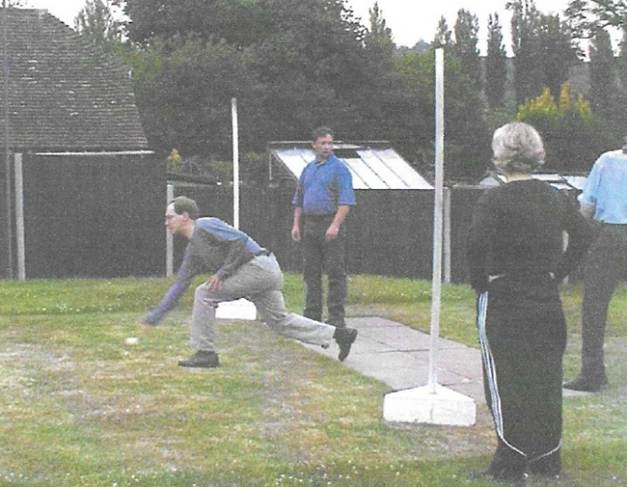
No bowler shall bowl more than one ball in six and the bowlers must bowl in their order of batting. If a team consists of five or less players, every sixth bowl is returned to the batter after a successful strike of the ball without attempting to hit the trap.
The bowler must have one foot behind the line and on the ground when bowling.
The batter must not touch the ball before it reaches the trap.
The fielding team must remain on the field during the innings.
In the event of a 'No Ball' a run shall be scored, and the batter cannot be bowled out. The player bowling the 'No Ball' will not bowl again until their next turn comes round.
One run is scored if the ball is hit between the posts and the bowler fails to knock down the flap.
The Match:
The above process continues until the entire batting team is out. The teams then change roles of batting and bowling and repeat the exercise. This constitutes one leg.
A declaration must be made when a team reaches 50 runs at the fall of the next wicket, unless otherwise decided by the two Captains - for example, if a player were in contention for the top runs award this would not be the case. If the other team reaches 50 then the first team returns to the trap and so on until the game is decided.
The team with the highest number of runs wins the leg. A match will consist of the best of three legs, with all three being played. In the event of a leg being a draw, the leg will be shared. One point shall be awarded for each leg or, in the event of a leg being a draw, half a point each, with the team winning the match gaining an additional point. The team with the most points at the end of the season will become the division winners.